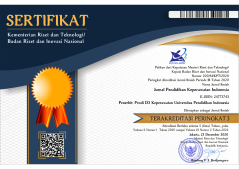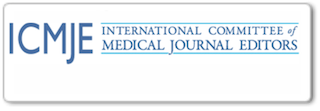Efektivitas Metode Video dan Demonstrasi terhadap Kangaroo Mother Care Self Efficacy
Abstract
ABSTRAK
Berat badan lahir rendah merupakan penyebab tertinggi angka kematian bayi. Bayi Berat Lahir Rendah(BBLR) beresiko mengalami hipotermi. Kangaroo Mother Care (KMC) atau perawatan metode kangguru merupakan salah satu intervensi hipotermi. Penelitian ini bertujuan untuk mengetahui perbedaan efektivitas video dan demonstrasi pada discharge planning terhadap kangaroo mother care self efficacy pada ibu yang memiliki BBLR. Metode penelitian menggunakan desain quasy experimental non randomized prettest and posttest dengan kelompok kontrol. Teknik sampling yang digunakan kuota sampling dengan jumlah 19 responden di setiap kelompok. Analisis data menggunakan independent sample t test. Hasil studi menunjukkan tidak ada perbedaan skor self efficacy antara kedua kelompok sesudah perlakuan (p=0,187) dengan nilai signifikansi 5%. Kedua metode edukasi baik video maupun demonstrasi sama-sama efektif untuk meningkatkan self efficacy. Perawat dapat menggunakan video untuk menggantikan demonstrasi saat melakukan discharge planning perawatan metode kangguru.
ABSTRACT
Low Birth Weight (LBW) is the highest cause of infant mortality in the first month of life. Low birth weight babies are at risk of experiencing hypothermia. One of the treatments for hypothermia is kangaroo mother care (KMC). The study aims to determine the differences in the effect of video and demonstration in discharge planning addressed to mother’s kangaroo mother care self-efficacy with low birth weight baby. This research used quasy experimental non-randomized pretest and posttest design. The sampling technique of this research used quota sampling, which was 19 respondents in each group. The data was analyzed using the Independent Sample t-Test. The result showed that there were no differences in self-efficacy scores between the video and demonstration groups after treatment (p=0,187) with a 5% score significant. Both methods, video, and demonstration education are equally effective in improving mother self-efficacy. Nurses can use video to replace demonstrations when performing discharge planning treatments for kangaroo mother care.
Keywords
Full Text:
PDFReferences
Amalia, L., & Herawati, E. (2018). Hubungan Pengetahuan dan Sikap Dalam Pelaksanaan Perawatan Metode Kangguru. Jurnal Pendidikan Keperawatan Indonesia. https://doi.org/10.17509/jpki.v4i2.13658
Anggraeni, I. A., Nurdiati, D. S., & Padmawati, R. S. (2016). Keberhasilan ibu bekerja memberikan ASI eksklusif. Jurnal Gizi Dan Dietetik Indonesia (Indonesian Journal of Nutrition and Dietetics), 3(2), 69–76. https://doi.org/10.21927/ijnd.2015.3(2).69-76
Astutiningrum, D., Hapsari, E. D., & Purwanta. (2016). Peningkatan Parenting Self Efficacy Pada Ibu Pasca Seksio Sesaria Melalui Konseling ( Improving Parenting Self Efficacy after Caesarean Section through Counselling ). Jurnal Ners. https://doi.org/10.1016/j.str.2015.10.016
Boundy, E. O., Dastjerdi, R., Spiegelman, D., Fawzi, W. W., Missmer, S. A., Lieberman, E., … Chan, G. J. (2016). Kangaroo Mother Care and Neonatal Outcomes: A Meta-analysis. Pediatrics, 137(1), e20152238. https://doi.org/10.1542/peds.2015-2238
Darliana, D. (2012). Discharge planning dalam keperawatan Discharge Planning in Nursing ; A Literature Review. Idea Nursing Journal.
Rahmawati, E., Susmarini, D., Lestari, P. & Putri, A.D. 2019, ‘Physical Stimulation For Hiperbilirubin’, IOP Conference Series: Earth and Environmental Science.
Fadillah. (2012). Teori Belajar Sosial Bandura. Modul Psikologi Perkembangan.
Feinstein, B. L., Sabates, R., Anderson, T. M., Sorhaindo, A., & Hammond, C. (2006). What are the effects of education on health? Education, 26(December 2005), 171–354. https://doi.org/http://www.oecd.org/edu/innovation-education/measuringtheeffectsofeducationonhealthandcivicengagement.htm
Flammer, A. (2015). Self-Efficacy. In International Encyclopedia of the Social & Behavioral Sciences: Second Edition. https://doi.org/10.1016/B978-0-08-097086-8.25033-2
Joshi, H. S., Srivastava, P. C., Agnihotri, a K., Joshi, M. C., Shalini, C., & Vipul, M. (2014). Risk Factors for Low Birth Weight ( LBW ) Babies and its Medico- Legal Significance. J Indian Acad Forensic Med.
Küçükoǧlu, S., & Çelebioǧlu, A. (2014). Effect of natural-feeding education on successful exclusive breast-feeding and breast-feeding self-efficacy of low-birth-weight infants. Iranian Journal of Pediatrics.
Lestari, Y., Nurhaeni, N., & Hayati, H. (2018). Penerapan Mobile Video Efektif Meningkatkan Pengetahuan Dan Sikap Ibu Dalam Menurunkan Lama Diare Balita Di Wilayah Puskesmas Kedaton Bandar Lampung. Jurnal Keperawatan Indonesia. https://doi.org/10.7454/jki.v21i1.546
Mahayana, S. A. S., Chundrayeti, E., & Yulistini. (2015). Faktor Risiko Yang Berpengaruh Terhadap Kejadian Badan Lahir Rendah di RSUP Dr. M. Djamil Padang. Jurnal Kesehatan Andalas.
Nilsen, H. (2009). Influence on Student Academic Behaviour through Motivation, Self-Efficacy and ValueExpectation: An Action Research Project to Improve Learning. University of Agder.
Notoatmodjo, S. (2012). Promosi Kesehatan dan Perilaku Kesehatan. Jakarta: Rineka Cipta.
Nurseha, & Annisa, Z. B. (2017). Faktor-Faktor Yang Berhubungan Dengan Kejadian BBLR. Faletehan Health Journal.
Pramudianti, D. C., Raden, A., & Suryaningsih, E. K. (2018). Hubungan tingkat pendidikan formal dengan parenting self-efficacy periode awal nifas pada ibu pasca sectio caesarea. Jurnal Kebidanan Dan Keperawatan Aisyiyah. https://doi.org/10.31101/jkk.194
Pratama, B. D., & Widodo, A. (2017). Hubungan Pengetahuan dengan Efikasi Diri pada Caregiver Keluarga Pasien Gangguan Jiwa di RSJD Dr. RM. Soedjarwadi. Jurnal Kesehatan. https://doi.org/10.23917/jurkes.v10i2.5524
Purwanto, A. D., & Wahyuni, C. U. (2016). Hubungan Antara Umur Kehamilan, Kehamilan Ganda, Hipertensi dan Anemia dengan Kejadian Bayi Berat Lahir Rendah (BBLR). Jurnal Berkala Epidemiologi. https://doi.org/10.20473/jbe.v4i3.
Rahmawati, E., Susmarini, D., Lestari, P., & Utami, A. (2018). Psysical Stimulation For Hyperbilirubinemia. In 1st International Conference on Multidisciplinary Approaches for Sustainable Rural Development (ICMA-SURE). Purwokerto: Research and Public Service Institute, Jenderal Soedirman University.
Riskesdas. (2018). Hasil Utama Riskesdas 2018. Kementrian Kesehatan Republik Indonesia. https://doi.org/1 Desember 2013
Rita Magdalena br. Tarigan, Restuning Widiasih, E. (2008). Pengetahuan ibu tentang penatalaksanaan perawatan bayi bblr di rumah di rskia kota bandung. Fakultas Ilmu Keperawatan Universitas Padjadjaran.
Rochimiwati, S. N., Mas’ud, & Giringan, J. (2013). Studi Pemberian MP-ASI Dini dan Status Gizi Bayi Umur 0-6 Bulan di Kelurahan Botang Kecamatan Makale Kabupaten Tana Toraja. Media Gizi Pangan, XV(1), 77–83.
Sholiha, H., & Sumarmi, S. (2015). ANALISIS RISIKO KEJADIAN BERAT BAYI LAHIR RENDAH ( BBLR ) PADA PRIMIGRAVIDA. Media Gizi Indonesia.
Sholiha, H., & Sumarmi, S. (2016). Analisis Risiko Kejadian Berat Bayi Lahir Rendah (Bblr) Pada Primigravida. Media Gizi Indonesia. https://doi.org/10.20473/MGI.V10I1.57-63
WHO. (2014). Global targets 2025.
Widiawati, S. (2017). Hubungan sepsis neonatorum , BBLR dan asfiksia dengan kejadian ikterus pada bayi baru lahir. Riset Informasi Kesehatan.
Yuniarti. (2015). Asuhan Tumbuh Kembang Neonatus Bayi – Balita Dan Anak Prasekolah. Bandung: Rafika aditama.
DOI: https://doi.org/10.17509/jpki.v5i2.19048
Refbacks
- There are currently no refbacks.
Jurnal Pendidikan Keperawatan Indonesia(JPKI) published by Indonesia University of Education. JPKI is licensed under a Creative Commons Attribution-ShareAlike 4.0 International License.
Office :
Nursing Department. FPOK UPI.
229, Dr. Setiabudhi Street. Bandung 40154
West Java , Indonesia
E-mail : jpki@upi.edu

_.png)
_.png)
_.png)











